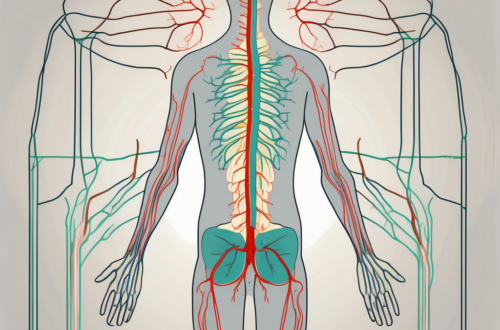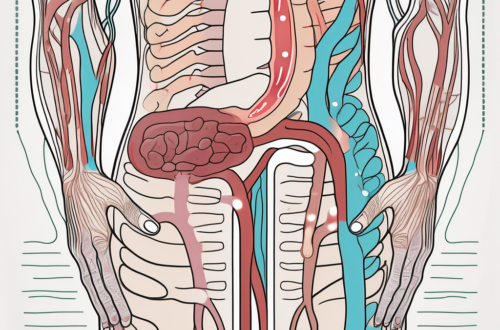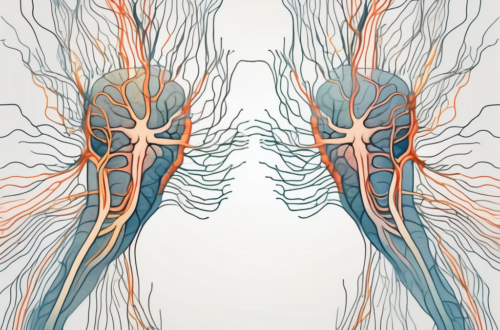The parasympathetic nerve innervating the lacrimal sac plays a crucial role in tear production and eye health. Understanding the function of this nerve can provide valuable insights into potential treatments for lacrimal sac disorders and open the door to new research directions in the study of the parasympathetic nervous system.
Understanding the Parasympathetic Nervous System
Before delving into the intricate connection between the parasympathetic nerve and the lacrimal sac, it is important to have a clear understanding of the parasympathetic nervous system as a whole.
The parasympathetic nervous system is one of the two main branches of the autonomic nervous system, working in harmony with the sympathetic nervous system. While the sympathetic nervous system is responsible for the body’s fight or flight responses, the parasympathetic nervous system regulates rest, digestion, and relaxation.
Within the parasympathetic nervous system, there are several key components that contribute to its overall function.
Key Components of the Parasympathetic Nervous System
The main components of the parasympathetic nervous system include the cranial nerves, which originate in the brainstem, and the sacral nerves, which originate in the lower spinal cord. These nerves carry signals to various organs and tissues throughout the body, regulating their activities.
Specifically, the cranial nerves are responsible for innervating structures in the head and neck, including the lacrimal sac.
One of the cranial nerves involved in the parasympathetic nervous system is the oculomotor nerve. This nerve plays a crucial role in controlling the muscles of the eye, including the muscles responsible for tear production. When the parasympathetic nervous system is activated, the oculomotor nerve stimulates the lacrimal gland, which produces tears. These tears then flow into the lacrimal sac, a small pouch located in the inner corner of the eye.
The lacrimal sac serves as a reservoir for tears, allowing them to accumulate before being drained into the nasolacrimal duct. This duct carries the tears into the nasal cavity, where they are eventually expelled through the nostrils. This drainage system helps to keep the eyes moist and clear, preventing dryness and irritation.
In addition to tear production, the parasympathetic nervous system also plays a role in regulating other functions of the lacrimal sac. It helps to control the secretion of mucus, which helps to lubricate the surface of the eye and protect it from foreign particles. The parasympathetic nerve fibers that innervate the lacrimal sac work in conjunction with other nerves and muscles to ensure proper tear and mucus production.
Overall, the parasympathetic nervous system plays a vital role in maintaining the health and function of the lacrimal sac. Its intricate connection with the cranial nerves and other components of the parasympathetic nervous system ensures that tear production and drainage are properly regulated, contributing to the overall well-being of the eyes.
The Lacrimal Sac and its Innervation
Now that we have a basic understanding of the parasympathetic nervous system, let’s focus on the lacrimal sac and how it is innervated.
Anatomy of the Lacrimal Sac
The lacrimal sac is a small pouch located in the inner corner of the eye. It plays a vital role in tear drainage, collecting tears produced by the lacrimal gland and transporting them into the nasolacrimal duct.
The lacrimal sac is surrounded by various structures, including muscles, blood vessels, and connective tissues, all of which contribute to its proper function.
The muscles surrounding the lacrimal sac help to facilitate the movement of tears into the sac. These muscles contract and relax, creating a pumping action that propels the tears towards the nasolacrimal duct.
The blood vessels surrounding the lacrimal sac provide it with a constant supply of oxygen and nutrients. This ensures the proper functioning of the sac and allows it to maintain its role in tear drainage.
The connective tissues surrounding the lacrimal sac provide structural support and help to maintain its shape. These tissues also play a role in protecting the sac from any external damage.
The Innervation Process
The innervation of the lacrimal sac is primarily controlled by the parasympathetic nerve, which sends signals to the lacrimal sac to stimulate tear production.
This process begins with the cranial nerves originating in the brainstem. The parasympathetic nerve fibers, which are part of the cranial nerves, carry the signals from the brainstem to the lacrimal sac.
As the parasympathetic nerve fibers travel through various pathways and synapses, they undergo a series of interactions and modulations. These interactions help to fine-tune the signals being sent to the lacrimal sac, ensuring the appropriate amount of tear production.
Once the parasympathetic nerve fibers reach the lacrimal sac, they interact with specific receptors located on the surface of the sac. These receptors are designed to recognize and bind to the neurotransmitters released by the nerve fibers.
When the parasympathetic nerve fibers interact with the receptors on the lacrimal sac, a cascade of events is triggered. This cascade ultimately leads to the release of neurotransmitters that stimulate tear production.
The neurotransmitters released by the parasympathetic nerve fibers bind to specific receptors on the lacrimal gland, which is responsible for tear production. This binding activates the lacrimal gland, causing it to produce and release tears into the lacrimal sac.
From the lacrimal sac, the tears are then transported through the nasolacrimal duct and eventually drain into the nasal cavity. This drainage process helps to keep the eyes moist and free from any excess tears.
In summary, the innervation of the lacrimal sac involves the parasympathetic nerve fibers originating in the brainstem, traveling through various pathways, and interacting with specific receptors on the sac. This interaction leads to the release of neurotransmitters that stimulate tear production, ensuring the proper functioning of the lacrimal system.
The Parasympathetic Nerve and the Lacrimal Sac
Now that we understand the innervation process of the lacrimal sac, let’s explore the connection between the parasympathetic nerve and the lacrimal sac in more detail.
The Connection between the Parasympathetic Nerve and the Lacrimal Sac
The parasympathetic nerve directly influences tear production in the lacrimal sac through its stimulation of the lacrimal gland. When tear production is insufficient, or the lacrimal gland is not properly stimulated, dryness and discomfort can occur.
Research has shown that disorders affecting the parasympathetic nervous system can result in improper tear production and drainage, leading to conditions such as dry eye syndrome or lacrimal sac obstruction.
It is important to note that consulting with a doctor is crucial if experiencing any issues with tear production or lacrimal sac function.
Furthermore, the parasympathetic nerve plays a vital role in maintaining the overall health and functioning of the lacrimal sac. This nerve pathway is responsible for regulating the secretion of tears, which are essential for lubricating and protecting the surface of the eye. Tears not only provide moisture but also contain important enzymes and antibodies that help fight off infections and maintain ocular health.
Moreover, the parasympathetic nerve fibers that innervate the lacrimal sac are intricately connected to the autonomic nervous system, which controls involuntary bodily functions. This connection allows the parasympathetic nerve to respond to various stimuli and adjust tear production accordingly. For example, when the eyes are exposed to irritants or foreign particles, the parasympathetic nerve signals the lacrimal gland to produce more tears, flushing out the irritants and protecting the ocular surface.
The Impact of the Parasympathetic Nerve on the Lacrimal Sac
Understanding the impact of the parasympathetic nerve on the lacrimal sac can provide insights into potential treatments and interventions for lacrimal sac disorders.
Medical professionals and researchers are continually exploring ways to modulate parasympathetic nerve activity to enhance tear production and alleviate symptoms associated with lacrimal sac dysfunction.
By targeting the parasympathetic nerve pathway that connects to the lacrimal sac, potential therapies and medications may be developed to address lacrimal sac disorders more effectively.
One promising area of research involves the use of neuromodulation techniques, such as electrical stimulation or pharmacological agents, to selectively activate or inhibit the parasympathetic nerve fibers that innervate the lacrimal sac. These techniques aim to restore the balance of tear production and drainage, providing relief for individuals suffering from lacrimal sac disorders.
Additionally, advancements in neuroimaging technology have allowed researchers to visualize and map the parasympathetic nerve pathways in the lacrimal sac more accurately. This detailed understanding of the nerve connections can aid in the development of targeted therapies and surgical interventions for lacrimal sac disorders.
Furthermore, ongoing studies are investigating the potential role of neuroprotective agents in preserving the function of the parasympathetic nerve and preventing or slowing down the progression of lacrimal sac disorders. These agents aim to protect the nerve fibers from damage or degeneration, ultimately preserving tear production and maintaining ocular health.
In conclusion, the parasympathetic nerve plays a crucial role in regulating tear production and maintaining the health of the lacrimal sac. Understanding the intricate connection between the parasympathetic nerve and the lacrimal sac opens up avenues for developing innovative treatments and interventions for lacrimal sac disorders, ultimately improving the quality of life for individuals affected by these conditions.
Unveiling the Function of the Parasympathetic Nerve
Now that we have examined the connection between the parasympathetic nerve and the lacrimal sac, let’s delve into the broader function of this nerve in tear production and eye health.
The parasympathetic nerve, also known as the cranial nerve III, plays a vital role in tear production by stimulating the lacrimal gland. When activated, the parasympathetic nerve triggers a series of physiological responses that result in tear secretion.
Tears are not just a sign of emotions; they are essential for maintaining the health and lubrication of the eyes. They help protect the cornea, the transparent front part of the eye, from drying out and becoming irritated. Tears also clear away debris, such as dust and allergens, that may enter the eyes. Additionally, tears provide nutrients and oxygen to the ocular surface, promoting overall eye health.
Therefore, any disruption in the parasympathetic nerve function can lead to dry eye syndrome or other ocular surface disorders. Dry eye syndrome is a common condition characterized by insufficient tear production or poor tear quality, resulting in discomfort, redness, and blurred vision.
The Parasympathetic Nerve and Eye Health
In addition to tear production, the parasympathetic nerve plays a role in various other aspects of eye health. It helps regulate blood flow to the eyes, pupil constriction, and focusing mechanisms.
When the parasympathetic nerve is functioning properly, it ensures an adequate blood supply to the eyes, delivering oxygen and nutrients to the various structures within the eye. This blood flow is crucial for maintaining optimal eye health and supporting the visual system.
Pupil constriction, also known as miosis, is another function controlled by the parasympathetic nerve. When exposed to bright light, the parasympathetic nerve signals the muscles in the iris to constrict the pupil, reducing the amount of light entering the eye. This protective mechanism prevents excessive light from damaging the sensitive structures of the eye.
Furthermore, the parasympathetic nerve plays a role in the focusing mechanisms of the eye. It helps control the ciliary muscle, which changes the shape of the lens to allow for near and far vision. Impaired parasympathetic nerve function can contribute to problems with near vision, making it difficult to focus on close objects.
Studies have shown that impaired parasympathetic nerve function can contribute to various eye conditions. For example, in glaucoma, a group of eye diseases characterized by damage to the optic nerve, impaired parasympathetic nerve function may disrupt the regulation of intraocular pressure, leading to increased pressure within the eye.
Pupil abnormalities, such as anisocoria (unequal pupil size) or abnormal reactions to light, can also be associated with parasympathetic nerve dysfunction. These abnormalities may indicate underlying neurological conditions or eye disorders that require further evaluation and treatment.
However, it is important to remember that only a qualified healthcare professional can diagnose and provide appropriate treatment for these eye conditions. Consulting with an ophthalmologist or neurologist is strongly recommended for individuals experiencing any eye-related symptoms or concerns.
Implications for Ophthalmology and Neurology
The connection between the parasympathetic nerve and the lacrimal sac has significant implications for both ophthalmology and neurology. It opens up potential avenues for improved treatments and future research directions.
The parasympathetic nerve, also known as the “rest and digest” system, plays a crucial role in tear production and overall eye health. When activated, this branch of the autonomic nervous system stimulates tear secretion, ensuring that the eyes remain moist and lubricated. The lacrimal sac, a small pouch located in the inner corner of the eye, acts as a reservoir for tears before they are drained into the nasal cavity.
Potential Treatments for Lacrimal Sac Disorders
Understanding the role of the parasympathetic nerve in tear production and its connection to the lacrimal sac can guide the development of targeted therapies for lacrimal sac disorders.
Researchers are exploring methods to modulate parasympathetic nerve activity, aiming to enhance tear production and alleviate symptoms associated with lacrimal sac dysfunction. One potential treatment approach involves the use of pharmacological agents that selectively activate the parasympathetic nerve, promoting tear secretion and improving overall eye comfort.
Additionally, advancements in surgical techniques have allowed for the development of minimally invasive procedures to address lacrimal sac disorders. These procedures aim to restore proper drainage of tears from the lacrimal sac, relieving symptoms such as excessive tearing and recurrent infections.
However, it is essential to consult with a qualified healthcare professional for proper diagnosis and treatment recommendations tailored to individual needs. Each case of lacrimal sac disorder may require a personalized approach, taking into account the underlying cause and severity of the condition.
Future Research Directions in Parasympathetic Nervous System Study
The complex interplay between the parasympathetic nerve and various anatomical structures, including the lacrimal sac, offers tremendous potential for future research.
Scientists are actively investigating the finer details of parasympathetic nerve regulation, seeking to uncover new insights into its function and explore how it can be manipulated to improve overall eye health. Recent studies have focused on identifying specific molecules and signaling pathways involved in parasympathetic nerve activation, with the aim of developing targeted therapies that can enhance tear production without causing unwanted side effects.
Furthermore, researchers are exploring the potential role of the parasympathetic nerve in other ocular conditions beyond lacrimal sac disorders. Preliminary evidence suggests that parasympathetic nerve dysfunction may contribute to the development of conditions such as dry eye syndrome and certain types of glaucoma. By expanding our understanding of the parasympathetic nervous system’s role in these conditions, we can potentially identify novel therapeutic targets and improve patient outcomes.
By pushing the boundaries of our knowledge through dedicated research efforts, we can unlock innovative treatments and interventions to address parasympathetic nervous system-related disorders. Collaboration between ophthalmologists, neurologists, and researchers from various disciplines will be crucial in advancing our understanding of the parasympathetic nerve’s role in eye health and developing effective treatment strategies.
In summary, the parasympathetic nerve innervating the lacrimal sac is a crucial component in tear production and eye health. Understanding the connection between the parasympathetic nerve and the lacrimal sac unveils the potential for improved treatments for lacrimal sac disorders and stimulates future research directions. However, it is always important to consult with a doctor to receive proper diagnosis and treatment recommendations tailored to individual needs. By harnessing the power of the parasympathetic nervous system, we can pave the way for enhanced eye health and well-being.





